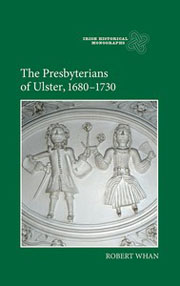Book contents
- Frontmatter
- Contents
- List of Illustrations
- Acknowledgements
- Colophon
- List of Abbreviations
- Editorial note
- Map showing principal places mentioned in the text and approximate presbytery boundaries (1704)
- Introduction
- 1 Ministers
- 2 Gentry
- 3 Merchants and Commerce
- 4 The Professions
- 5 The Lower Orders
- 6 Organisation and Religious Practice
- Conclusion
- Bibliography
- Index
5 - The Lower Orders
Published online by Cambridge University Press: 05 March 2014
- Frontmatter
- Contents
- List of Illustrations
- Acknowledgements
- Colophon
- List of Abbreviations
- Editorial note
- Map showing principal places mentioned in the text and approximate presbytery boundaries (1704)
- Introduction
- 1 Ministers
- 2 Gentry
- 3 Merchants and Commerce
- 4 The Professions
- 5 The Lower Orders
- 6 Organisation and Religious Practice
- Conclusion
- Bibliography
- Index
Summary
The Presbyterian elite, in terms of the ministers, gentry, merchants and professionals has already been considered. This chapter is concerned with those at the lower levels of the social and occupational structure. Material for reconstructing the lives of these non-elite groups is not abundant and when they do appear in the surviving sources it is usually as observed rather than observers. Nevertheless, because they formed the largest group in Presbyterian society they cannot be ignored. Contemporaries and modern historians have both recognised the importance of the middling and lower orders to Irish Presbyterianism. Bishop William King of Derry recognised that the bulk of the common people in Ireland were either Dissenters or ‘Papists’, and Toby Barnard has stated that Presbyterian congregations derived their strength from the middle and lower orders. Within the last five decades, social historians have shown an increasing interest in the historically less-articulate members of early modern English society but only more recently has an interest for the topic developed among historians of Ireland. Barnard considers the lower orders in his New anatomy and servants of the gentry in The King's and Queen's Counties (modern-day Laois and Offaly) are given attention in a doctoral thesis by Daniel Beaumont. The poor, and poor relief, have been the subject of articles by David Dickson, Rowena Dudley and Rosalind Mitchison, and have been the focus of an excellent, though rarely cited, thesis by Patrick Fitzgerald.
- Type
- Chapter
- Information
- The Presbyterians of Ulster, 1680-1730 , pp. 156 - 177Publisher: Boydell & BrewerPrint publication year: 2013

